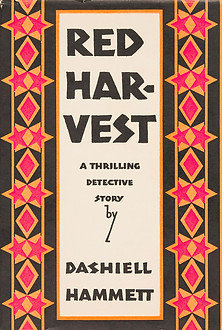
In 2023, Enemy of the People had two revivals: one in London's West End starring Matt Smith (Dr. Who), and another on Broadway, which was directed by Tony-winner Sam Gold (Fun Home) and won Jeremy Strong (Succession) the Tony Award for Best Actor for his portrayal of Dr. Stockmann. This Broadway production received four additional Tony nominations.
Henrik Ibsen, who also authored A Doll's House and Peer Gynt, is considered one of the most influential playwrights in Western literature and is known as “the father of realism”. He is the most frequently performed dramatist after Shakespeare - and was nominated three times for the Nobel Prize in Literature.

Red Harvest & Dashiell Hammett

Red Harvest has yet to be made into a film, though there have been several attempts since its publication. Bernardo Bertolucci wrote an adaptation in the 70s that had Robert Redford, Jack Nicholson, Warren Beatty up for the lead role, but the project never went through. Martin Scorcese was also drawn to it. Hammett's writing has been a major source of inspiration for the Coen Brothers and Akira Kurosawa, whose film noir Yojimbo was inspired by another of his novels, The Glass Key. Clint Eastwood's character in Sergio Leone's The Good, the Bad, and the Ugly and the other works in the Dollars Trilogy was inspired by The Op.
Film noir was noted for its striking cinematography, often rendered in a stunning black-and-white inspired by German Expressionism. Favorite noir locations included wet nighttime streets and tense offices with shards of light filtered through venetian blinds.

OUR UPCOMING PROJECT...
Semester Cinema runs biannualy. Our next iteration will be for the Winter/Spring semester of 2026.
We're currently working to develop our screenplay for the upcoming iteration. We’ll continue to hold optional monthly Zoom meetings for students who would like to follow the progress, weigh in on specific scenes or the deliberations about the script as a whole. Students are also invited to submit written script notes or re-draft scenes and submit them for consideration.
We’ll also produce a feature-length documentary during our time together – and students interested in documentary filmmaking will make it – and are invited to join our discussion on that film’s subject. In 2024, we shot a feature-length doc about the housing crisis on Nantucket. That film is now starting to circulate to film festivals.
For our narrative film, we’re trying something new for this next screenplay, by merging two stories – Henrik Ibsen's Tony-winning play, An Enemy of the People, and Dashiell Hammett's acclaimed crime novel, Red Harvest – into a gripping noir film.
Henrik Ibsen & An Enemy of the People
Written in 1882, An Enemy of the People tells the story of Dr. Thomas Stockmann, a physician who discovers that the water supply to his town’s drinking reservoir and newly built bathhouse are contaminated. He acts immediately to inform his community about this urgent public health matter, and he sets out to expose the truth in the local newspaper - but he faces opposition from local leaders and his brother, the mayor, who are concerned that the revelation of the scandal could upset the status quo and even wipe the town from the map.
Red Harvest is a 1929 thriller set in a small town consumed by still-festering conflicts between union activists and strikebreakers after a labor dispute. The novel is considered the very first example of writing that would lead to the later identification of the “noir” genre – so-named by French film critics who discovered and loved American crime films, after World War II.
The novel follows Hammett's recurring detective character "The Op," who is called into town to look into police force corruption being reported by a local newspaper editor. The first problem: the editor who called him in was murdered right before his arrival. The Op remains in town to investigate, thrusting himself into the town's political turmoil and, in the process, threatening his own life and sanity.
Film Noir & Our Project
Dashiell Hammett’s name is closely associated with the advent of film noir, due to the adaptations of his work for films including The Maltese Falcon and The Thin Man. Film noir is arguably the most influential and popular of all film genres. It was first identified by French film critics who couldn’t see American pictures during WWII. After the Nazi ban was lifted, in 1945, French audiences feasted on a cornucopia of Hollywood gangster pictures marked by a darkened mood, taut suspense, femme fatales, clipped and pointed dialogue, and vivid, unpredictable characters haunted by skeletons in their closet.
American critics initially disparaged the early noirs that were frequently low-budget B-movies intended to screen as the second feature on a double bill. This was back in the days before television when more than 30 million Americans went to see movies every week. Hollywood worked overtime to keep up. Film noir articulated themes well-suited to modern times, as our society grappled with the aftermath of world war, the possibility of nuclear conflict, a loosened morality and inexplicable crime driven by greed and desperation in a dog-eat-dog universe.
We love the action, suspense, noir mood and vivid characters in Red Harvest. We’re drawn to the ideas of family and community and the rich, timely themes that include environmentalism, whistleblowing, risk-taking for something larger - and democracy - in An Enemy of the People. For our adaptation, we’re inviting four of five characters from An Enemy of the People to enter the world of Red Harvest. Through each draft, we will draw them ever-more into the same narrative and world. We currently plan to set the film in 1957 – and we may shoot it in black-and-white.
We're excited by the creative and intellectual opportunities and challenges this hybrid story will present for our students and crew. Our key task is to make it all resonate as something powerful and fully original.